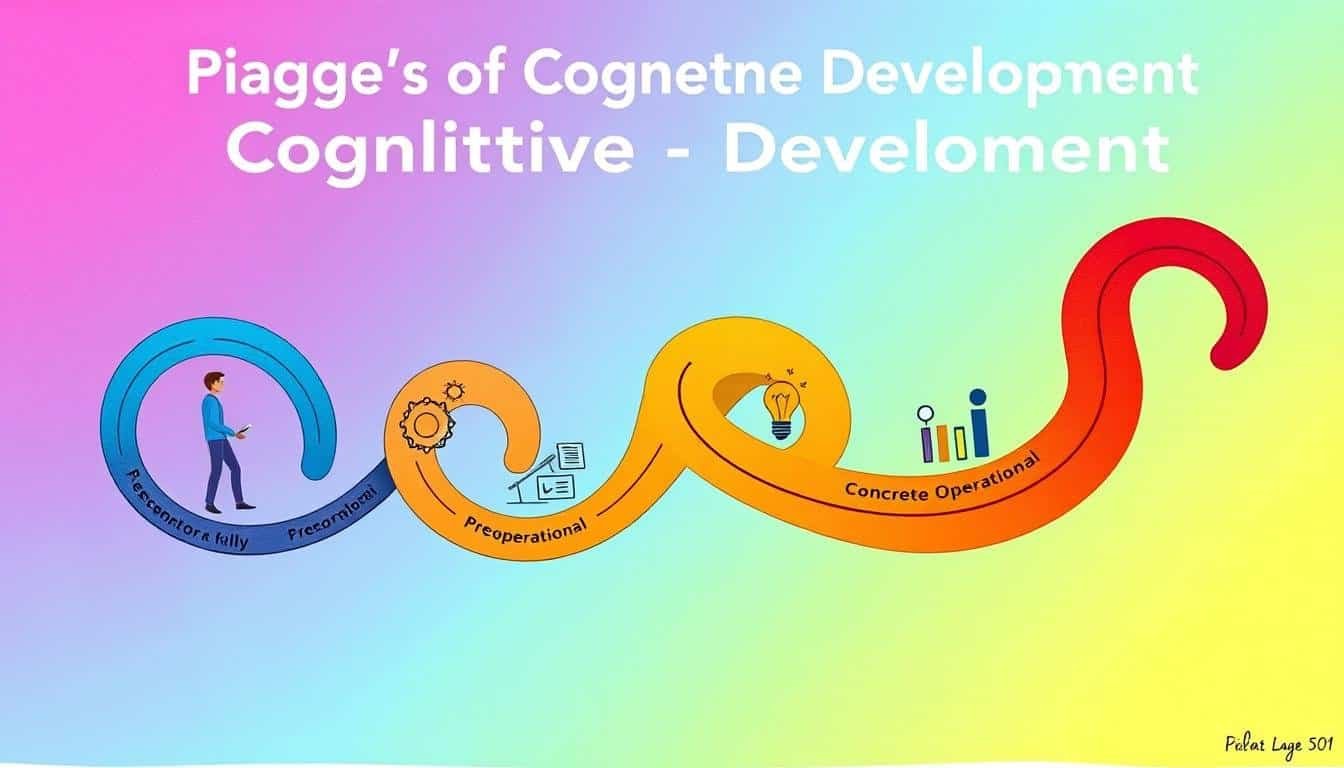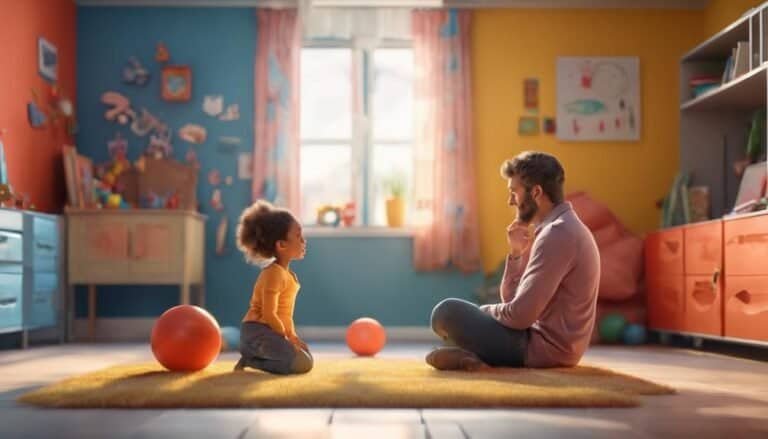Understanding Piaget’s Stages of Cognitive Development
Have you ever thought about why kids see the world differently than grown-ups? This question is key to Piaget’s Stages of Cognitive Development. Jean Piaget’s theory shows how kids change their thinking and understanding in different stages. They move from the early Sensorimotor stage to the complex thinking of the Formal Operational stage as they grow.
Piaget’s work shed light on important milestones in child development, like understanding objects and using symbols. His insights are still vital today. They help parents and teachers guide kids and show that kids play a big part in their own learning.
Key Takeaways
- Piaget identified four distinct stages in children’s cognitive development: Sensorimotor, Preoperational, Concrete Operational, and Formal Operational.
- Each stage marks qualitative changes in thinking and understanding of the world around them.
- The Sensorimotor stage focuses on sensory experiences and the development of object permanence.
- During the Preoperational stage, children hone symbolic thinking but may struggle with egocentric perspectives.
- Concrete Operational stage introduces logical reasoning and the ability to understand conservation principles.
- Adolescents in the Formal Operational stage engage in abstract thought, allowing for hypothesizing and theoretical understanding.
- Pivotal to Piaget’s theory is the idea that children actively engage with their environment to develop cognitive schemas.
Introduction to Piaget’s Theory
Jean Piaget, a Swiss psychologist, changed how we see cognitive development in the early 1900s. His Piaget theory shows that kids don’t just soak up information. They actively explore their world. He laid out four stages of development: sensorimotor, preoperational, concrete operational, and formal operational.
The sensorimotor stage is from birth to about two years old. Kids learn important skills by interacting with their world. They figure out that objects still exist even when they can’t see them and how actions cause effects. They use their senses and actions to understand the world.
From ages two to seven, kids are in the preoperational stage. They start to think symbolically. They imitate, play symbolically, and tell stories, showing they’re getting better at thinking.
Then, from seven to eleven, kids enter the concrete operational stage. They start to think logically. They understand that things stay the same and can be reversed. They work with real objects and situations.
Finally, the formal operational stage starts at eleven and goes into adulthood. People can think deeply, solve complex problems, and use logic on abstract situations.
These stages are key times in cognitive development. They shape how kids see and interact with the world. They set the stage for their learning later on.
What Are Piaget’s Stages of Cognitive Development?
Jean Piaget, a famous psychologist, talked about four main stages of thinking growth. These stages are called the Piaget stages. Each stage shows important steps in how kids learn and understand the world.
The Sensorimotor Stage is from birth to age 2. Kids start to know that objects still exist even when they can’t see them. They learn a lot by using their senses and touching things.
From ages 2 to 7, kids are in the Preoperational Stage. They can think symbolically, but they often see things only from their own view. They use their imagination a lot, seen in their play and stories.
Between ages 7 to 11, kids enter the Concrete Operational Stage. They start to think logically and understand concrete events. They can figure out things that are real, but abstract ideas are still hard for them.
Then, from adolescence on, kids reach the Formal Operational Stage. They can think scientifically and solve complex problems. They can think about what-ifs and compare different solutions.
Each stage is key to a child’s growth. It’s shaped by both their biology and what they experience. Knowing these stages helps us understand how kids learn and interact with others.
Overview of the Sensorimotor Stage
The sensorimotor stage is a key part of growing up, from birth to about two years old. Babies and toddlers learn by touching, seeing, and moving. They explore the world around them. This stage has six main parts, each with big steps in learning.
Characteristics of the Sensorimotor Stage
In this stage, kids grow by doing different things. These include:
- Reflex acts: These are natural reactions to things, seen in the first month.
- Primary circular reactions: Babies do this from 1 to 4 months, repeating actions that feel good.
- Secondary circular reactions: From 4 to 8 months, babies repeat actions that make their world better.
- Coordinating secondary schemes: By 8 to 12 months, kids start to plan their actions.
- Tertiary circular reactions: Kids try different things and see what happens, from 8 to 12 months.
- Early symbolic thought: Around 18-24 months, kids start to think symbolically, which helps with complex thinking later.
Cognitive Milestones in Infants
There are big steps in learning during the sensorimotor stage. One big step is understanding that things still exist even if we can’t see them. This starts between 4 to 7 months and gets clearer by 18-24 months.
- Learning about cause and effect starts around 4 to 8 months.
- Trying different things to solve problems helps kids learn, starting at 4 to 8 months.
- Playing pretend around 18 months helps with creativity and talking.
- Understanding how actions affect things is another big step.
Being responsive to kids during this time helps them feel safe and trust others. Activities like sucking, crawling, and reaching help with motor skills and learning.
| Cognitive Milestone | Typical Age of Emergence |
|---|---|
| Object Permanence | 4-7 months |
| Cause and Effect | 4-8 months |
| Pretend Play | 18 months |
| Symbolic Thought | 18-24 months |
Knowing about these milestones helps caregivers and teachers support kids’ growth. It shows that what kids learn early affects their future learning and thinking.
Understanding the Preoperational Stage
The preoperational stage is from ages two to seven. It’s a big change in how kids think. Kids start to show their creativity and use their imagination a lot. They learn to think symbolically, which helps them be creative but also makes it hard to see things from another person’s point of view. They often see things only from their own perspective, which is called egocentrism.
Key Features of the Preoperational Stage
Here are the main things that happen in the preoperational stage:
- Symbolic Thinking: Kids start using symbols like words and pictures to stand for things and events.
- Imaginative Play: Kids get better at pretending, taking on different roles in their play.
- Egocentrism: They find it hard to see things from anyone else’s point of view.
- Centration: They tend to focus on just one part of a situation, which can lead to wrong ideas about numbers or size.
- Animism and Artificialism: They think objects can move on their own and that people make the world around them.
Importance of Symbolic Thinking
Symbolic thinking is key for learning language and how to talk to others. It lets kids share complex thoughts and feelings with friends. This thinking helps them play and learn in new ways. As kids get older, they start to see things from other people’s viewpoints. By age seven, most kids have moved past seeing things only from their own view. This stage is important for getting ready for more thinking and learning later on.
Insights Into the Concrete Operational Stage
The concrete operational stage is a key time in brain growth, happening from ages 7 to 11. Kids see a big leap in their ability to think logically. They start to understand real-world concepts better, using actual objects to learn about them.
This stage is crucial for building the skills needed for more complex thinking later on.
Logical Thinking Development
Kids start to use inductive reasoning well, making conclusions from specific examples. They’re good at making general rules but might find deductive logic tricky. They can now look at different parts of a problem and see how objects relate to each other.
They also get better at sorting things based on what they have in common. This shows a big leap in how they process information.
Understanding Conservation
Learning about conservation is a big deal at this stage. Kids figure out that changing a substance’s shape doesn’t change its volume or weight. For instance, they know pouring water from a wide glass into a thin one doesn’t change the water’s amount.
They also understand that actions can be reversed, which helps them grasp conservation better. This thinking helps them see things from other people’s viewpoints. Doing hands-on experiments helps them learn these important concepts.
| Characteristic | Description |
|---|---|
| Age Range | Approximately 7 to 11 years |
| Logical Thinking | Development of inductive reasoning, with challenges in deductive logic |
| Conservation | Understanding that quantity remains the same despite changes in shape |
| Reversibility | Recognition that actions can be reversed |
| Decentration | Ability to focus on multiple aspects of a problem |
| Classification | Understanding of hierarchies and categories |
| Seriation | Capability to organize objects based on quantitative dimensions |
Exploring the Formal Operational Stage
The formal operational stage starts around age 12 and marks a big change in thinking skills. At this time, people start to think about abstract ideas and reason with complex logic. This stage changes how teens solve problems and see the world, making them think about ethics and moral values.
Abstract Thought and Reasoning
When teens reach the formal operational stage, they can handle abstract ideas without needing real-life examples. They learn to reason logically and solve problems step by step. For example, they can figure out how to balance a scale by age 13, showing they’re getting better at thinking.
This growth in thinking skills lets them solve complex problems and think scientifically. They can come up with many solutions to tough issues.
Moral and Ethical Understanding
As teens think more abstractly, they start to look deeper into moral and ethical questions. They face tough choices and think about different sides of an issue. This makes them more aware of themselves and their choices.
They begin to see the ethical sides of their actions. This stage not only boosts their thinking skills but also shapes their values and ethics.
The Role of Schemas in Cognitive Development
Schemas are key to understanding how our minds grow, especially in Jean Piaget’s theories. They help us organize and make sense of the world. This shapes how kids see and interact with their surroundings.
As kids move through different stages of growth, their schemas change. At first, they are simple and mainly based on reflexes in newborns. As they face new things, they either:
- Assimilate: This means they fit new info into what they already know, without changing their ideas.
- Accommodate: Here, kids adjust their schemas to include new info that doesn’t fit at first.
This ability to change is crucial for learning. Schemas get more complex as kids learn from their experiences. For instance, in the sensorimotor stage, babies start to play with objects. This helps them understand the world better. Their schemas help them make sense of things and their role in them.
The table below shows how schemas change through Piaget’s four stages:
| Stage | Age Range | Description of Schemas |
|---|---|---|
| Sensorimotor | Birth to 2 years | Basic reflexes and interactions with the environment. |
| Preoperational | 2 to 7 years | Symbolic thinking starts; schemas become more complex. |
| Concrete Operational | 7 to 11 years | Logical reasoning develops; understanding of conservation. |
| Formal Operational | 11 to 15 years | Abstract thinking; complex reasoning and problem-solving emerge. |
This shows that schemas aren’t fixed. They change as our minds grow. As kids get older, they get better at adding new info to their schemas. This lets them understand more complex ideas and deal with a bigger, more complex world.
Assimilation and Accommodation: Key Processes in Learning
Understanding assimilation and accommodation is key to seeing how we learn, says Piaget’s theory. Assimilation is when we fit new info into what we already know without changing it. For instance, a child might see a zebra and think it’s a horse because they look similar.
Accommodation is the opposite. It means changing what we know or making new ideas to fit new info that doesn’t match what we thought before. If a child learns zebras are not horses, they might make a new group for zebras. This back-and-forth between assimilation and accommodation is crucial for growing our minds.
Piaget also talks about equilibration, which means finding a balance between these two. When kids face new ideas that challenge what they know, they try to adjust. This balance is important for growing their thinking from being babies to teenagers.
Assimilation and accommodation are key in how we think and learn. They help build our mental frameworks as we grow. Assimilation makes learning easier by fitting new info into what we already know. Accommodation makes us think deeper by challenging and improving our understanding.
| Concept | Description | Example |
|---|---|---|
| Assimilation | Integration of new information into existing schemas | Classifying a zebra as a horse due to similar features |
| Accommodation | Modification of existing schemas to include new information | Creating a new category for zebras after realizing they are not horses |
| Equilibration | Balancing assimilation and accommodation for cognitive growth | Adjusting thought processes when faced with cognitive challenges |
Comparing Piaget’s Theory to Vygotsky’s Theory
When we look at cognitive development theories, we see a big difference between Piaget and Vygotsky. Piaget believed in a stage-based approach, focusing on how kids interact with their world. Vygotsky, however, stressed the role of social interactions and culture in development.
Vygotsky saw language as key to cognitive growth. He talked about three types of language: social, private, and inner speech. Each type plays a unique role in how kids develop. Piaget, on the other hand, thought language comes from thought. It’s a way to share ideas that are already in our minds.
Vygotsky’s idea of the Zone of Proximal Development (ZPD) is all about learning with help from others. He believed that adults can guide kids in their learning. This is different from Piaget, who thought peer interaction was crucial for growth.
These two thinkers also had different views on development. Vygotsky saw it as ongoing, shaped by social factors. Piaget, however, talked about universal stages that kids go through. This shows a big difference in how they see the impact of culture and social factors on thinking.
For educators and researchers, understanding Piaget vs Vygotsky is key. It helps shape how we teach and design learning spaces.
The Influence of Cultural Context on Cognitive Development
Culture greatly affects how kids learn and grow. It shapes their learning world. For instance, kids from families that make pottery in Mexico learn about conservation faster than others. This shows how certain cultural activities help kids understand things earlier.
Research by Dasen shows big differences in how kids from different cultures develop. Inuit kids in Canada, Baoul kids in Africa, and Aranda kids in Australia learn at different ages. This is because of their unique societies and environments. It makes us rethink the idea that kids go through cognitive stages in the same order.
How kids learn also depends a lot on their education. Culture and the way schools work affect how kids solve problems and see the world. In the West, schools often focus on thinking alone and solving problems on your own. In the East, learning is more about understanding relationships and the context.
This shows that how kids think and learn is not just about growing up. It’s also about their culture. Knowing this helps teachers and psychologists make learning better for everyone. By understanding these differences, we can make learning fit the needs of all kinds of students.
Applications of Piaget’s Stages of Cognitive Development in Education
Piaget’s theory helps us understand how students grow in their thinking abilities. It shows that learning should match the student’s mental level. This means giving them activities that fit their age and thinking skills.
Teachers use Piaget’s stages to make learning meaningful. For example, in the concrete operational stage, hands-on activities help students understand math better. Using tools like Cuisenaire rods helps them see complex ideas clearly, improving their thinking.
Adding activities that challenge what students know can really boost their learning. This method makes them think more deeply and explore new ideas. As students get older, teaching them to solve complex problems and think abstractly can help them think more deeply.
Teachers can check how students are doing by regularly testing them. Changing how they teach based on what students know makes lessons more effective. This approach helps create a classroom where everyone grows and learns together.
| Stage | Age Range | Key Education Strategies |
|---|---|---|
| Sensorimotor | Birth to 2 years | Exploratory play, sensory activities |
| Preoperational | 2 to 7 years | Symbolic play, storytelling to aid imagination |
| Concrete Operational | 7 to 11 years | Hands-on materials, visual aids, group work |
| Formal Operational | 11 years and beyond | Abstract reasoning tasks, problem-solving discussions |
Using Piaget’s ideas, teachers can really help students grow in their thinking. By understanding how kids think, teachers can make learning fun and complete.
Conclusion
Learning about Piaget’s stages of cognitive development is key to understanding how kids learn and see the world. This summary shows how thinking grows in steps, from the early stages to the final ones. It helps teachers and caregivers know how to help kids grow their minds at each stage.
Knowing about the preoperational stage shows us how kids think differently. Kids in this stage often focus too much on one thing and see things from their own view. This helps us teach them better by understanding their way of thinking.
Piaget’s ideas still shape how we teach today, showing that learning should match a child’s mental growth. By creating a learning space that respects these stages, we help kids learn better. This way, we support their unique growth and improve their learning success.







